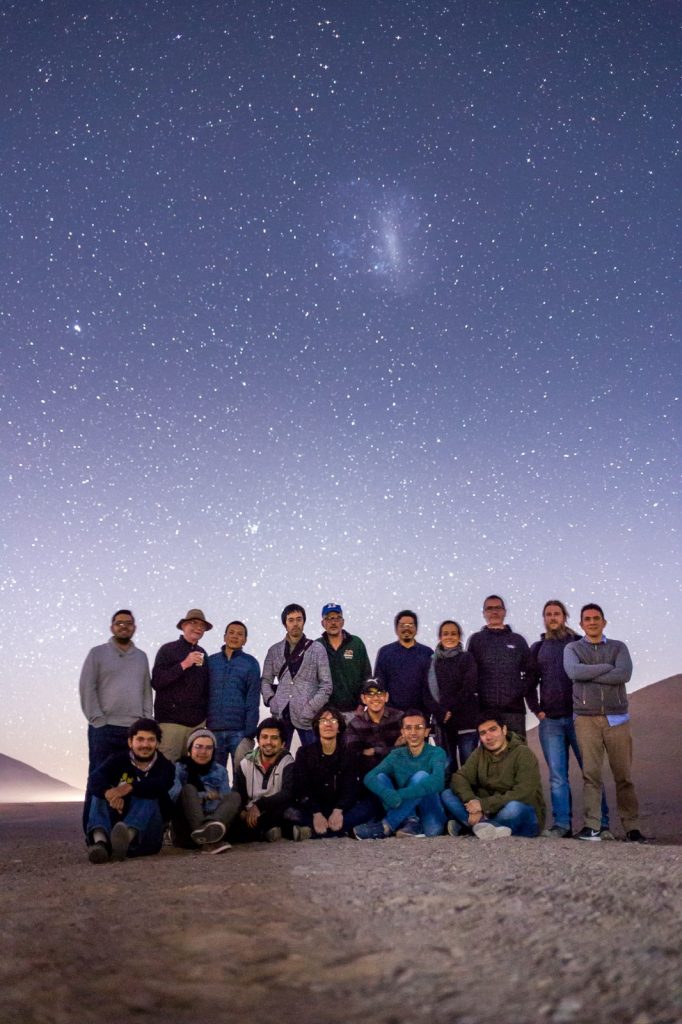The international complex, that hosts four 8 meter telescopes, has been one of the main points for the development of relevant research related to astronomy, nationwide and worldwide.
Under the scope of the 1st International Workshop on Compressive, Adaptive and Computational Imaging (WACCI 2019), organized by professor Esteban Vera from the School of Electrical Engineering, PUCV, a group conformed by researchers and students visited the European Southern Observatory installations, which is located in Cerro Paranal, 75 miles south fom Antofagasta, in the Antofagasta region, northern Chile.
After the arrival to Antofagasta on November 15th, thr tour started with a short walk to see the natural monument, La Portada, one of the main local tourist attractions. After a two hour bus trip to Cerro Paranal, the visit had a quick review about the Observatory and safety rules, which was done in the visitor center, place where usually the official guides also talk about the main characteristics of the complex and the daily life and work that is done there as well. There is a small-size replica of the observatory, which can be found at the entrance.
After that, the group had the opportunity to have a short walk into the underground residences, where all the crew and researchers from the observatory live during their duties. Then,there was a visit to the big workshop where the mirror maintenance is performed, where Maxime Boccas, chief engineer of the observatory who gently offered to serve as the technical guide, commented about the challenges related to handling such gigantic pieces of optical glass.
Once transported to the top of Cerro Paranal, there was a short walk around the nearby zone outside the huge telescopes, the group could check the interiors of the Yepún telescope, where they could experience the opening of the main covers and the fine movements of the main axes of the telescope that handle the gigantic 8-meter mirror, and the specialized instrumentation and equipment. Finally, it was the time to access the control room of the observatory, section where all the tasks related to the night observation and measurements are done.

Once the guided visit ended, the assistants participated of an astronomical observation session a few meters away from the Mano del desierto, another touristic spot of Antofagasta placed 45 miles to the south of the city.

With perfect weather conditions, the skies allowed to see and check a great amount of celestial objects: among them, the Large Magellanic Cloud, Saturn, and also some stars and constellations. In the place, there were various telescopes and binoculars provided by the tour operator, Turismo Ruhiscos, and the night ended with snacks and drinks while the moon was solemnly rising.
Reactions
Andrés Guerrero, postgraduate student from the Universidad Industrial de Santander, Colombia, said that “academically speaking, this visit was very appropriate for me because right now I’m working in adaptive optics related stuff. To see the functioning of the telescope was very interesting, and the guides were very experimented. Everything was very complete”.
“So, for the correct functioning of an observatory, you must be very isolated, so you can avoid the visual contamination from the cities, for example. Even knowing that, it is very unbelievable to see where the observatory is placed: in the middle of nowhere and over a sea of clouds (…) The most surprising thing for me was the telescope’s mechanism (…) from an engineering point of view, is also remarkable to see how they optimized all that structure so they could be able to decrease the friction between that and the floor”, added by his side, Camilo Weinberger, researcher assistant of the PUCV’s School of Electrical Engineering optoelectronics lab.

The European Southern Observatory (ESO) shines on its effort to connect the scientific and technological development with a rich offer of outreach activities: among them, guided visits to the buildings. For further information, check out the official website of the ESO.






